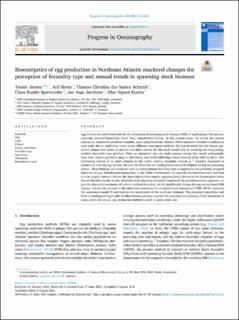| dc.description.abstract | Egg surveys are used worldwide for the estimation of spawning stock biomass (SSB) of small pelagic fish species, requiring detailed knowledge about their reproductive biology. In the present study, we revisit the current conceptual framework of teleost fecundity types using Northeast Atlantic (NEA) mackerel (Scomber scombrus) as case study due to conflicting views across different assessment methods. We hypothesized that the herein presented unique time series on protein and lipid content for this stock would help in resolving the long-lasting, intrinsic fecundity type problem. First, we document that the body surplus energy has varied substantially over time, with a significant drop to historically low levels following a stock increase from 2005 to 2015. This fluctuating pattern is in stark contrast to the stable relative fecundity (oocyte g−1 females) measured in connection with the egg surveys. Second, we show that the feeding levels are at the highest during the spawning season. These findings are consistent with an indeterminate fecundity type as opposed to the presently accepted determinate-type classification dating back to the 1990s. Furthermore, we quantify the batch fecundity and find it to be largely constant. Hence, the main reproductive output regulator that is driven by the bioenergetic status should therefore be the number of batches shed. Based on this novel framework for an indeterminate spawner, we provide alternative estimates of relative realized fecundity, which significantly change the egg survey-based SSB indices, reduces the contrast to the other data sources in the mackerel stock assessment (1990–2019), improves the assessment model fit and reduces the uncertainty of the stock size estimate. The presented algorithms and lines of thinking are applicable to other teleosts and may improve the precision and accuracy of the estimation in cases where the annual egg production method is used to assess stock size. | en_US |
